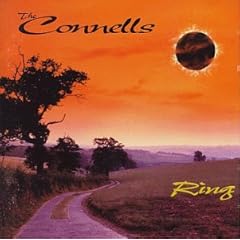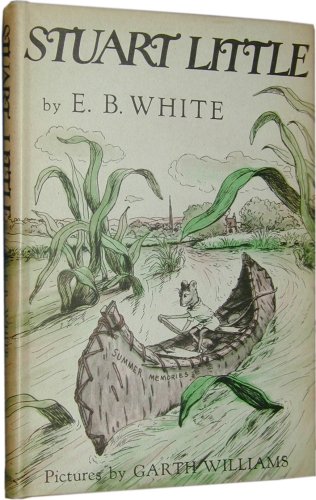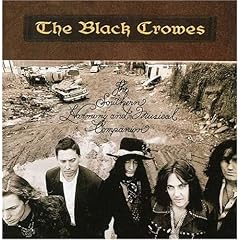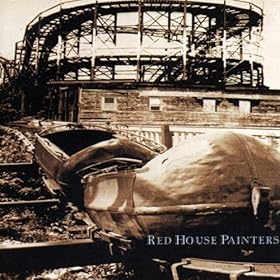Honestly, this week and next week (and maybe even the week after that), we're still in the territory of Albums That Made the List at the Last Minute. I like them a lot -- they're on here for a reason -- but in a different mood, I might have chosen something else in their place. Also, at least four of the artists below (with the exception being the gentleman at #94) are on the list despite the fact that I like several bands and singers more who
aren't on the list. I guess this is where I'll disclose that the Rolling Stones didn't make the cut. In addition to being more (much more) of a Beatles guy, the Stones to me are a collection of songs chosen from various albums. There are 15-20 Stones songs that I
love, but they're scattered over the course of the band's 432-year career. So, with that in mind, here are a few selections from people with less (sometimes much, much less) stature than the Stones:
95. Peter Gabriel -- Us (1992)
 So
So had the bigger hits -- “In Your Eyes,” “Sledgehammer,” “Big Time” -- but I prefer this follow-up. It was a long time coming, released six years after
So, and it’s wildly uneven. If everything on here was as good as my three or four favorites, the album might be 50 spots higher. Then again, without one or two of those favorites, it wouldn’t even come close to being considered at all.
The review on Amazon complains that “the pop psychology of ‘Love to Be Loved’ and ‘Washing of the Water’ is overwrought.” But, come on. We’re talking about someone whose
very best songs contain lyrics like “in your eyes / the light, the heat / in your eyes / I am complete.” Peter Gabriel traffics in overwrought pop psychology (just look at that cover image -- it has to be the goofiest on the list); some of it is just better than the rest. On “Come Talk to Me,” “Blood of Eden,” and “Secret World,” Gabriel walks right up to that overwrought line and straddles it, the result being that you shake your head at feeling so moved by songs trying so hard to move you.
94. Lyle Lovett -- Lyle Lovett (1986)

Lovett’s 1986 debut arrived complete with his trademark dry wit, reedy vocals, and musical catholicity. On “God Will,” he sings to a cheating lover that God will keep trusting her, loving her, and saying he wants her, but he won’t. (“God will / but I won’t / and that’s the difference / between God and me.”) “This Old Porch” (co-written with Robert Earl Keen) is certainly the best song that ever has -- or could -- include the lyric “this old porch is like a steamin’, greasy plate of enchiladas / with lots of cheese and onions and a guacamole salad.”
But it’s on the ballads “If I Were the Man You Wanted” and “Closing Time” that Lovett proves -- as he has time and again -- that beneath the clever, stoic, private persona is a large, attentive heart.
According to the collective wisdom at Wikipedia,
Lyle Lovett was named “one of the top 100 albums of the 1980s by the Italian magazines
Il Mucchio Selvaggio and
Velvet.” I rest my case.
93. The Connells -- Ring (1993)

The standards I'm using here vary from album to album. The same way that Peter Gabriel benefited from a few standouts, The Connells benefit equally from an emphasis on consistency. There aren’t any songs among the 13 here that would make a list of my 300 favorite songs (with the possible exception of “New Boy”), but there isn’t a throwaway in the bunch. Sure, The Connells would probably like to be R.E.M. and end up closer to the Gin Blossoms, but you don’t get the sense that they’re underachieving. Just the opposite. None of the elements here are outstanding, but they add up. On two occasions -- “74-75” and “Spiral” -- the band (successfully) veers into ballad territory, but otherwise this is just mid-tempo, jangly rock, with lyrics that can be both funny and sad, as in, “If I disappointed you, I’m so sorry / You’re a disappointment, too.”
92. Band of Horses -- Cease to Begin (2007)

This is the most recently released album on the list, which means five or ten years from now it will have undoubtedly climbed up or fallen off. This band’s first two records are remarkably well produced.
I’m sure many people would choose the debut,
Everything All the Time, instead, but I think this one is slightly more diverse. The band's confidence and ambition are clear from the start. Like
The Joshua Tree -- on a lesser scale, of course --
Cease to Begin puts three of its best songs right at the front end. Those three and "Cigarettes, Wedding Bands," in which the band crafts a singalong chorus from the word "lied," guarantee this album's lasting power.
91. George Michael -- Listen Without Prejudice, Vol. 1 (1990)

For some, this will require the most vigorous defense of any of the 100, but it shouldn’t. Male pop stars have a harder time being taken seriously than female pop stars. I’m sure there are several academic departments scattered around the country that are devoted to Madonna. But George Michael -- who can actually sing and has at least as many good songs as she does -- is just a punch line to late-night-TV jokes about public restrooms.
It’s true that this is one of the weirdest entries on the list. After Michael’s debut solo album,
Faith, became a huge hit, he could have emerged with a shiny follow-up. Instead, he mounted an attack on his own image and recorded a set of loungy and somber songs. The exception, of course, was the radio smash “Freedom ‘90,” but the lyrics to that song spoke very directly to Michael’s dissatisfaction with his image, and he pointedly
replaced himself in the video with a string of supermodels. The rest of the record features a faithful cover of Stevie Wonder’s haunting “They Won’t Go When I Go,” an overly earnest but somehow still effective song about the fact that “God stopped keeping score” (“Praying for Time”), and a really great centerpiece (“Waiting for That Day”). The result was a record that sold "just" two million copies in the U.S., after which Michael has never been as big a star.
To balance out the Gabriel image above,
Listen Without Prejudice also has one of my very favorite covers -- an unadorned, severely cropped version of a shot taken at Coney Island in 1940 by the photographer Weegee. Here’s the complete photo:

Labels: 100 Albums
The more books we read, the sooner we perceive that the true function of a writer is to produce a masterpiece and that no other task is of any consequence. Obvious though this should be, how few writers will admit it, or having made the admission, will be prepared to lay aside the piece of iridescent mediocrity on which they have embarked! Writers always hope that their next book is going to be their best, for they will not acknowledge that it is their present way of life which prevents them from ever creating anything different or better.







































